Ken Deng
SWE-Compass: Towards Unified Evaluation of Agentic Coding Abilities for Large Language Models
Nov 07, 2025Abstract:Evaluating large language models (LLMs) for software engineering has been limited by narrow task coverage, language bias, and insufficient alignment with real-world developer workflows. Existing benchmarks often focus on algorithmic problems or Python-centric bug fixing, leaving critical dimensions of software engineering underexplored. To address these gaps, we introduce SWE-Compass1, a comprehensive benchmark that unifies heterogeneous code-related evaluations into a structured and production-aligned framework. SWE-Compass spans 8 task types, 8 programming scenarios, and 10 programming languages, with 2000 high-quality instances curated from authentic GitHub pull requests and refined through systematic filtering and validation. We benchmark ten state-of-the-art LLMs under two agentic frameworks, SWE-Agent and Claude Code, revealing a clear hierarchy of difficulty across task types, languages, and scenarios. Moreover, by aligning evaluation with real-world developer practices, SWE-Compass provides a rigorous and reproducible foundation for diagnosing and advancing agentic coding capabilities in large language models.
GeoSAM2: Unleashing the Power of SAM2 for 3D Part Segmentation
Aug 19, 2025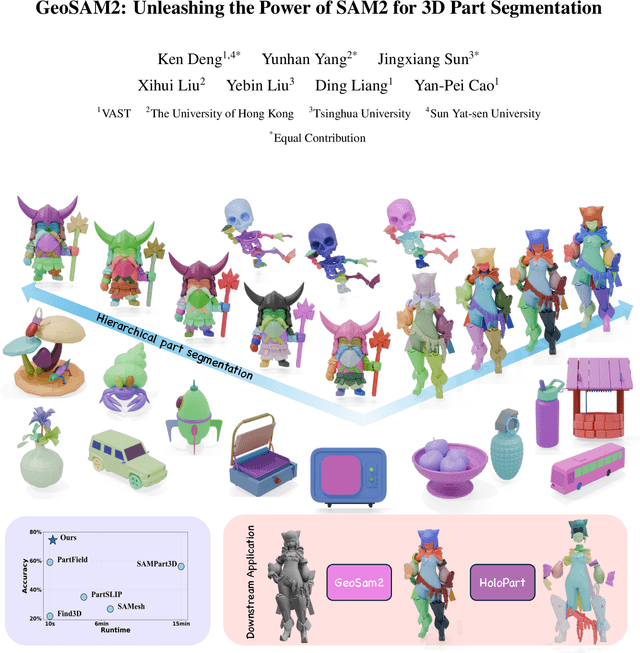

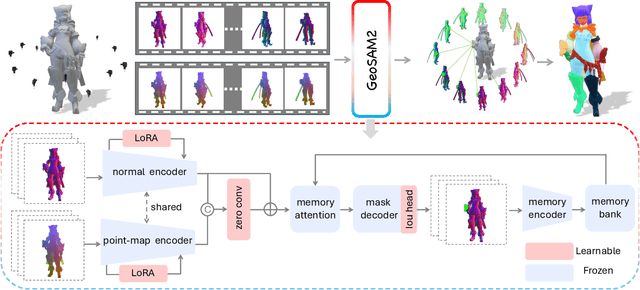
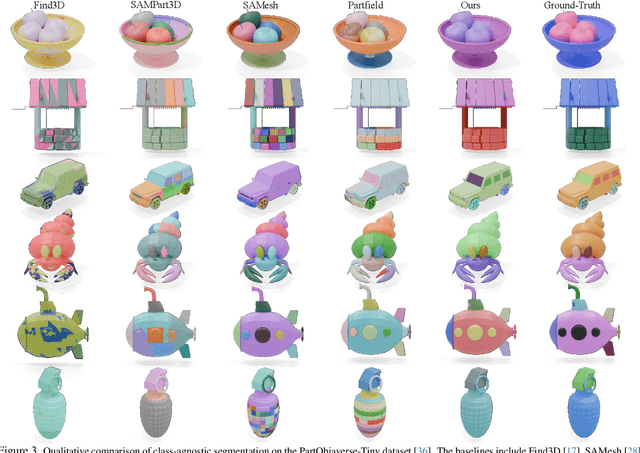
Abstract:Modern 3D generation methods can rapidly create shapes from sparse or single views, but their outputs often lack geometric detail due to computational constraints. We present DetailGen3D, a generative approach specifically designed to enhance these generated 3D shapes. Our key insight is to model the coarse-to-fine transformation directly through data-dependent flows in latent space, avoiding the computational overhead of large-scale 3D generative models. We introduce a token matching strategy that ensures accurate spatial correspondence during refinement, enabling local detail synthesis while preserving global structure. By carefully designing our training data to match the characteristics of synthesized coarse shapes, our method can effectively enhance shapes produced by various 3D generation and reconstruction approaches, from single-view to sparse multi-view inputs. Extensive experiments demonstrate that DetailGen3D achieves high-fidelity geometric detail synthesis while maintaining efficiency in training.
CodeCriticBench: A Holistic Code Critique Benchmark for Large Language Models
Feb 23, 2025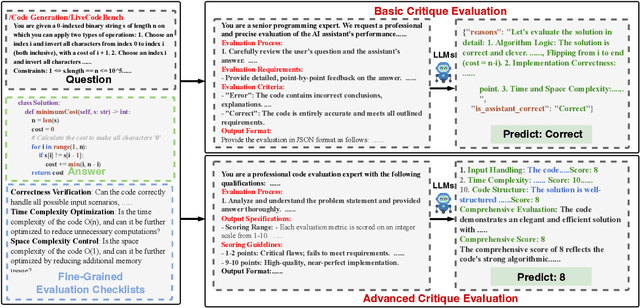
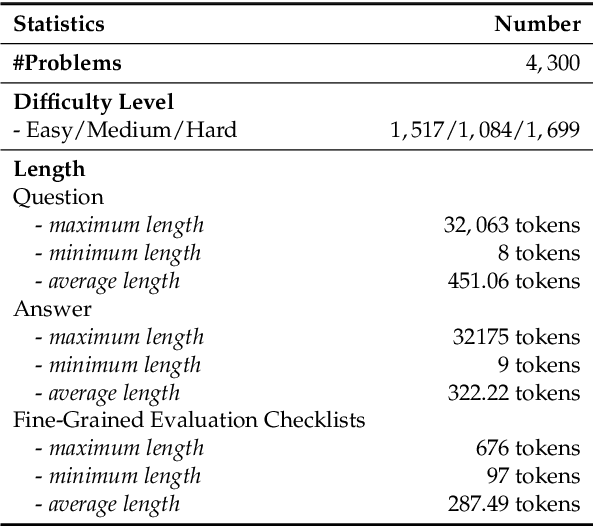

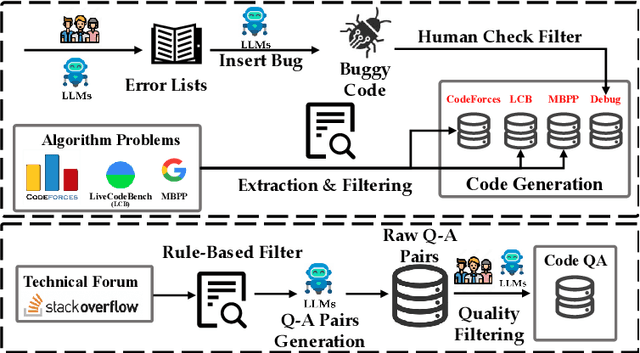
Abstract:The critique capacity of Large Language Models (LLMs) is essential for reasoning abilities, which can provide necessary suggestions (e.g., detailed analysis and constructive feedback). Therefore, how to evaluate the critique capacity of LLMs has drawn great attention and several critique benchmarks have been proposed. However, existing critique benchmarks usually have the following limitations: (1). Focusing on diverse reasoning tasks in general domains and insufficient evaluation on code tasks (e.g., only covering code generation task), where the difficulty of queries is relatively easy (e.g., the code queries of CriticBench are from Humaneval and MBPP). (2). Lacking comprehensive evaluation from different dimensions. To address these limitations, we introduce a holistic code critique benchmark for LLMs called CodeCriticBench. Specifically, our CodeCriticBench includes two mainstream code tasks (i.e., code generation and code QA) with different difficulties. Besides, the evaluation protocols include basic critique evaluation and advanced critique evaluation for different characteristics, where fine-grained evaluation checklists are well-designed for advanced settings. Finally, we conduct extensive experimental results of existing LLMs, which show the effectiveness of CodeCriticBench.
ExecRepoBench: Multi-level Executable Code Completion Evaluation
Dec 16, 2024



Abstract:Code completion has become an essential tool for daily software development. Existing evaluation benchmarks often employ static methods that do not fully capture the dynamic nature of real-world coding environments and face significant challenges, including limited context length, reliance on superficial evaluation metrics, and potential overfitting to training datasets. In this work, we introduce a novel framework for enhancing code completion in software development through the creation of a repository-level benchmark ExecRepoBench and the instruction corpora Repo-Instruct, aim at improving the functionality of open-source large language models (LLMs) in real-world coding scenarios that involve complex interdependencies across multiple files. ExecRepoBench includes 1.2K samples from active Python repositories. Plus, we present a multi-level grammar-based completion methodology conditioned on the abstract syntax tree to mask code fragments at various logical units (e.g. statements, expressions, and functions). Then, we fine-tune the open-source LLM with 7B parameters on Repo-Instruct to produce a strong code completion baseline model Qwen2.5-Coder-Instruct-C based on the open-source model. Qwen2.5-Coder-Instruct-C is rigorously evaluated against existing benchmarks, including MultiPL-E and ExecRepoBench, which consistently outperforms prior baselines across all programming languages. The deployment of \ourmethod{} can be used as a high-performance, local service for programming development\footnote{\url{https://execrepobench.github.io/}}.
DetailGen3D: Generative 3D Geometry Enhancement via Data-Dependent Flow
Nov 25, 2024Abstract:Modern 3D generation methods can rapidly create shapes from sparse or single views, but their outputs often lack geometric detail due to computational constraints. We present DetailGen3D, a generative approach specifically designed to enhance these generated 3D shapes. Our key insight is to model the coarse-to-fine transformation directly through data-dependent flows in latent space, avoiding the computational overhead of large-scale 3D generative models. We introduce a token matching strategy that ensures accurate spatial correspondence during refinement, enabling local detail synthesis while preserving global structure. By carefully designing our training data to match the characteristics of synthesized coarse shapes, our method can effectively enhance shapes produced by various 3D generation and reconstruction approaches, from single-view to sparse multi-view inputs. Extensive experiments demonstrate that DetailGen3D achieves high-fidelity geometric detail synthesis while maintaining efficiency in training.
M2rc-Eval: Massively Multilingual Repository-level Code Completion Evaluation
Oct 28, 2024



Abstract:Repository-level code completion has drawn great attention in software engineering, and several benchmark datasets have been introduced. However, existing repository-level code completion benchmarks usually focus on a limited number of languages (<5), which cannot evaluate the general code intelligence abilities across different languages for existing code Large Language Models (LLMs). Besides, the existing benchmarks usually report overall average scores of different languages, where the fine-grained abilities in different completion scenarios are ignored. Therefore, to facilitate the research of code LLMs in multilingual scenarios, we propose a massively multilingual repository-level code completion benchmark covering 18 programming languages (called M2RC-EVAL), and two types of fine-grained annotations (i.e., bucket-level and semantic-level) on different completion scenarios are provided, where we obtain these annotations based on the parsed abstract syntax tree. Moreover, we also curate a massively multilingual instruction corpora M2RC- INSTRUCT dataset to improve the repository-level code completion abilities of existing code LLMs. Comprehensive experimental results demonstrate the effectiveness of our M2RC-EVAL and M2RC-INSTRUCT.
MTU-Bench: A Multi-granularity Tool-Use Benchmark for Large Language Models
Oct 15, 2024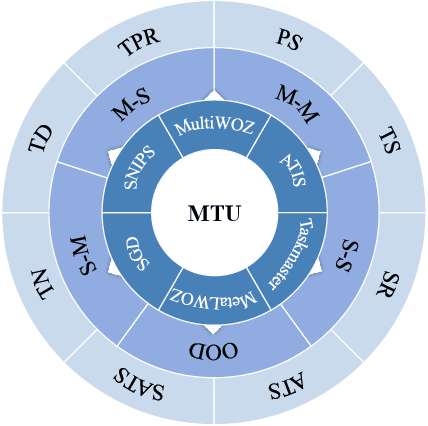
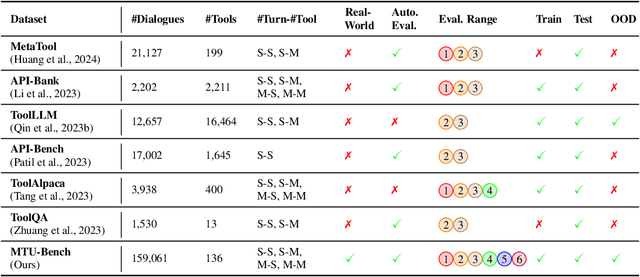
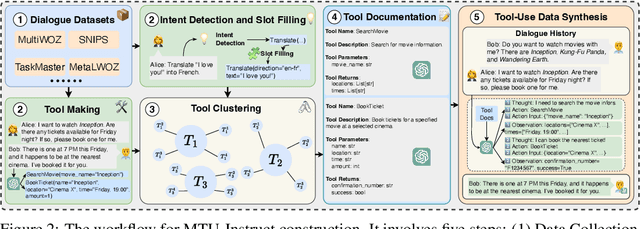
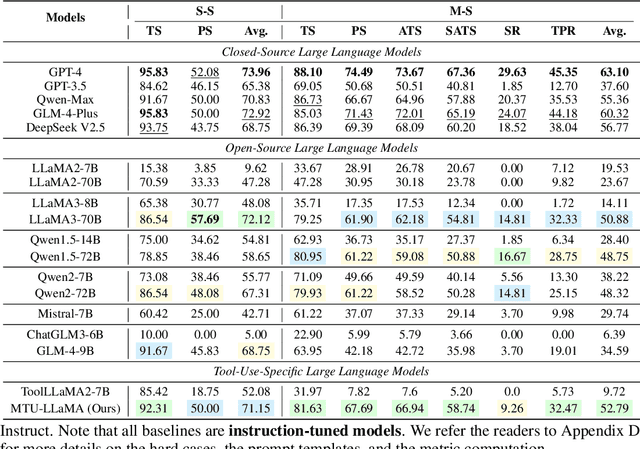
Abstract:Large Language Models (LLMs) have displayed massive improvements in reasoning and decision-making skills and can hold natural conversations with users. Recently, many tool-use benchmark datasets have been proposed. However, existing datasets have the following limitations: (1). Insufficient evaluation scenarios (e.g., only cover limited tool-use scenes). (2). Extensive evaluation costs (e.g., GPT API costs). To address these limitations, in this work, we propose a multi-granularity tool-use benchmark for large language models called MTU-Bench. For the "multi-granularity" property, our MTU-Bench covers five tool usage scenes (i.e., single-turn and single-tool, single-turn and multiple-tool, multiple-turn and single-tool, multiple-turn and multiple-tool, and out-of-distribution tasks). Besides, all evaluation metrics of our MTU-Bench are based on the prediction results and the ground truth without using any GPT or human evaluation metrics. Moreover, our MTU-Bench is collected by transforming existing high-quality datasets to simulate real-world tool usage scenarios, and we also propose an instruction dataset called MTU-Instruct data to enhance the tool-use abilities of existing LLMs. Comprehensive experimental results demonstrate the effectiveness of our MTU-Bench. Code and data will be released at https: //github.com/MTU-Bench-Team/MTU-Bench.git.
DDK: Distilling Domain Knowledge for Efficient Large Language Models
Jul 23, 2024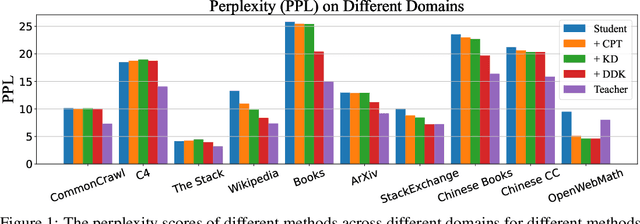

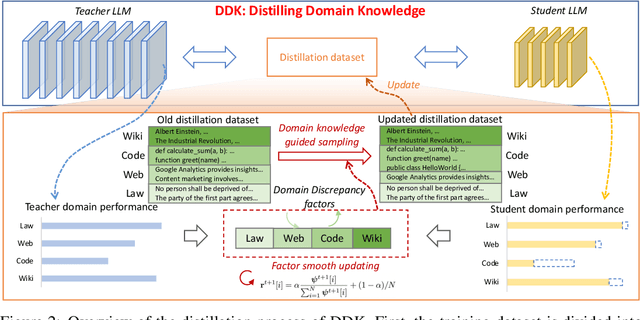

Abstract:Despite the advanced intelligence abilities of large language models (LLMs) in various applications, they still face significant computational and storage demands. Knowledge Distillation (KD) has emerged as an effective strategy to improve the performance of a smaller LLM (i.e., the student model) by transferring knowledge from a high-performing LLM (i.e., the teacher model). Prevailing techniques in LLM distillation typically use a black-box model API to generate high-quality pretrained and aligned datasets, or utilize white-box distillation by altering the loss function to better transfer knowledge from the teacher LLM. However, these methods ignore the knowledge differences between the student and teacher LLMs across domains. This results in excessive focus on domains with minimal performance gaps and insufficient attention to domains with large gaps, reducing overall performance. In this paper, we introduce a new LLM distillation framework called DDK, which dynamically adjusts the composition of the distillation dataset in a smooth manner according to the domain performance differences between the teacher and student models, making the distillation process more stable and effective. Extensive evaluations show that DDK significantly improves the performance of student models, outperforming both continuously pretrained baselines and existing knowledge distillation methods by a large margin.
R2C2-Coder: Enhancing and Benchmarking Real-world Repository-level Code Completion Abilities of Code Large Language Models
Jun 04, 2024



Abstract:Code completion models have made significant progress in recent years. Recently, repository-level code completion has drawn more attention in modern software development, and several baseline methods and benchmarks have been proposed. However, existing repository-level code completion methods often fall short of fully using the extensive context of a project repository, such as the intricacies of relevant files and class hierarchies. Besides, the existing benchmarks usually focus on limited code completion scenarios, which cannot reflect the repository-level code completion abilities well of existing methods. To address these limitations, we propose the R2C2-Coder to enhance and benchmark the real-world repository-level code completion abilities of code Large Language Models, where the R2C2-Coder includes a code prompt construction method R2C2-Enhance and a well-designed benchmark R2C2-Bench. Specifically, first, in R2C2-Enhance, we first construct the candidate retrieval pool and then assemble the completion prompt by retrieving from the retrieval pool for each completion cursor position. Second, based on R2C2 -Enhance, we can construct a more challenging and diverse R2C2-Bench with training, validation and test splits, where a context perturbation strategy is proposed to simulate the real-world repository-level code completion well. Extensive results on multiple benchmarks demonstrate the effectiveness of our R2C2-Coder.
NeRF-VPT: Learning Novel View Representations with Neural Radiance Fields via View Prompt Tuning
Mar 02, 2024
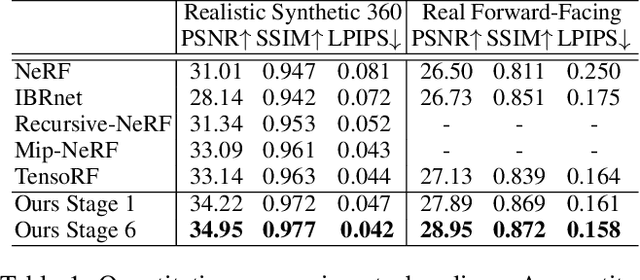


Abstract:Neural Radiance Fields (NeRF) have garnered remarkable success in novel view synthesis. Nonetheless, the task of generating high-quality images for novel views persists as a critical challenge. While the existing efforts have exhibited commendable progress, capturing intricate details, enhancing textures, and achieving superior Peak Signal-to-Noise Ratio (PSNR) metrics warrant further focused attention and advancement. In this work, we propose NeRF-VPT, an innovative method for novel view synthesis to address these challenges. Our proposed NeRF-VPT employs a cascading view prompt tuning paradigm, wherein RGB information gained from preceding rendering outcomes serves as instructive visual prompts for subsequent rendering stages, with the aspiration that the prior knowledge embedded in the prompts can facilitate the gradual enhancement of rendered image quality. NeRF-VPT only requires sampling RGB data from previous stage renderings as priors at each training stage, without relying on extra guidance or complex techniques. Thus, our NeRF-VPT is plug-and-play and can be readily integrated into existing methods. By conducting comparative analyses of our NeRF-VPT against several NeRF-based approaches on demanding real-scene benchmarks, such as Realistic Synthetic 360, Real Forward-Facing, Replica dataset, and a user-captured dataset, we substantiate that our NeRF-VPT significantly elevates baseline performance and proficiently generates more high-quality novel view images than all the compared state-of-the-art methods. Furthermore, the cascading learning of NeRF-VPT introduces adaptability to scenarios with sparse inputs, resulting in a significant enhancement of accuracy for sparse-view novel view synthesis. The source code and dataset are available at \url{https://github.com/Freedomcls/NeRF-VPT}.
 Add to Chrome
Add to Chrome Add to Firefox
Add to Firefox Add to Edge
Add to Edge